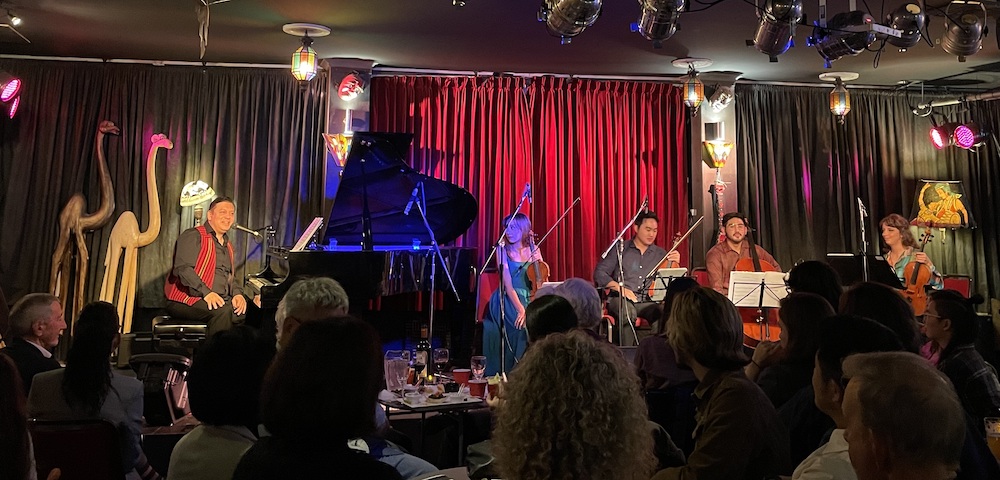Daniel Rojas spins his dazzling improvisations with ease at the launch of his new album.
“Un,
Dos,
Un, dos, tres…”
With these words, pianist and composer Daniel Rojas kicks off his performance with Ensemble Apex Strings at the launch of his new album Bliss of Heaven: Music of the New World. Chilean-born Australian Daniel Rojas’ name is synonymous with brilliant Latin American pianism, grounded in the classical idiom. His aim he says, is to bring the “Latin American vernacular music into the classical concert hall.” He is achieving this with astonishing and popular success. In the high-octane performance that unfolds, Rojas and Ensemble Apex Strings stir the passions and seduce our souls.
The album was recorded in São Paulo, Brazil in 2019, with Rojas, the Baldini Quartet and Australian bandoneon player Stephen Cuttriss. The Baldini Quartet was to join Rojas in Australia for this program, but COVID-19 put paid to these plans and Rojas mounted a search for an Australian ensemble which had the technical capabilities he required as well as the ability to realise the Latin American aesthetic that is so crucial to his work. The Ensemble Apex Strings, comprising violinists Anna Da Silva Chen and Tim Yu, viola player Sophie Nickel and cellist Noah Oshiro, were the answer to his quest. The bandoneon would have completed the soundscape this evening, but it was not be. The effect, nonetheless, is reminiscent of the ‘tango orchestra’ which includes violins, piano, double bass (its parts played tonight by the cello and viola) and bandoneon.
The program comprises nine pieces, mostly from the CD. Two are Rojas’s compositions; seven are arranged by him. A multiple award winner, he holds a PhD and is Program Director of Composition at the Sydney Conservatorium of Music, University of Sydney.
Rojas’ original works are a testament to his creativity. SalTango (a fusion of the salsa and the tango) is a sinewy, pulsating piece with leaning chromatics. There is syncopation, and breathtaking arpeggiation driven by a thrumming ostinato, setting the mood for the evening. Navegar is an achingly beautiful slow tango which talks of nostalgia and homesickness.
There are two very familiar pieces – the languid Bésame Mucho by the Mexican songwriter Consuelo Velázquez, in an exquisite arrangement by Rojas, which could easily be a slow movement from a chamber piece of the Romantic era, with its beautiful soliloquy from the violin; La cumparsita by the Uruguayan Gerardo Matos Rodríguez and Roberto Firpo an Argentine pianist, composer and band leader, is a fiercely full-blooded tango.
Central to the program are two works by the legendary Astor Piazzolla. Libertango, arguably his best-known piece, has been arranged by Rojas. In a stroke of genius, Rojas integrates the chord progressions of J S Bach’s Prelude in C minor BWV 847 from Book 1 of the Well-Tempered Clavier, into the prelude. After its throbbing start, the tempo slows as the piano hints at the baroque treasure to come, before the astonishing reveal and then a return to the irresistible original theme.
Rojas performs his arrangement of Piazzolla’s Resurreción del ángel (Resurrection of the Angel) as a heart-stopping piano solo. He remains true to Piazzolla’s introspective frame of mind which incorporates a religious element in this triptych. The last of three pieces in The Angel Series, Resurreción del ángel follows Milonga del Angel (Dance of the Angel) and La Muerte del Angel (Death of the Angel). Rojas poignantly expresses the gentle serenity of the angel, the gravity and anger of death, finally celebrating the triumph and barely contained power of the resurrection.
Hanacpachap Cussicuinin translates as ‘Bliss of Heaven,’ from which the album takes its name. Written anonymously in the early 1600s, it is the first example of published polyphony in the ‘New World.’ It could be straight out of a medieval troubadour’s song book with its insistent rhythm and thin harmonies. Then there is music from the Andes, the charming Valicha by Delgado and from Cuba, Mambo Influenciado by Valdez, again referencing the music of JS Bach with a cadenza, beautifully played by Da Silva Chen.
The popular Tico Tico non fubá, a Brazilian song by Zequinha de Abreu and El Cóndor Pasa, by Peruvian composer Daniel Alomía Robles are added to the program, much to the delight of Rojas’ fans.
There is tremendous chemistry between Rojas and the Ensemble Apex Strings, cohesive and dynamic. Rojas is a charismatic performer whose music gives us a window into several worlds. His music speaks of myriad colours and tales from across Latin America; music of the old world is fused with the new; classical traditions are woven into indigenous Latin American aesthetics, paying homage to the great masters. Rojas spins his dazzling improvisations with ease, combining his music with entertaining insights and historical narratives. These earworms will take a while to dispel.

Recent Comments